John Lewis Ltd: Competitive Forces & Strategic Planning Report
VerifiedAdded on 2020/10/05
|13
|3913
|309
Report
AI Summary
This report provides a comprehensive analysis of John Lewis Ltd's business strategy, examining both the internal and external environments that influence its operations. It begins by assessing the impact of the macro environment using PESTEL analysis, highlighting the effects of political, economic, social, technological, environmental, and legal factors on John Lewis's strategies. The report then delves into the internal environment, employing SWOT analysis to evaluate the company's strengths, weaknesses, opportunities, and threats. Furthermore, Porter's Five Forces model is applied to evaluate the competitive forces within John Lewis's industry, including the threat of new entrants, the threat of substitutes, the bargaining power of buyers and suppliers, and the intensity of competitive rivalry. Finally, the report interprets and devises strategic planning for John Lewis Ltd, utilizing relevant theories, concepts, and models to provide actionable recommendations for enhancing the company's competitive position and overall performance.

Business Strategy
Paraphrase This Document
Need a fresh take? Get an instant paraphrase of this document with our AI Paraphraser
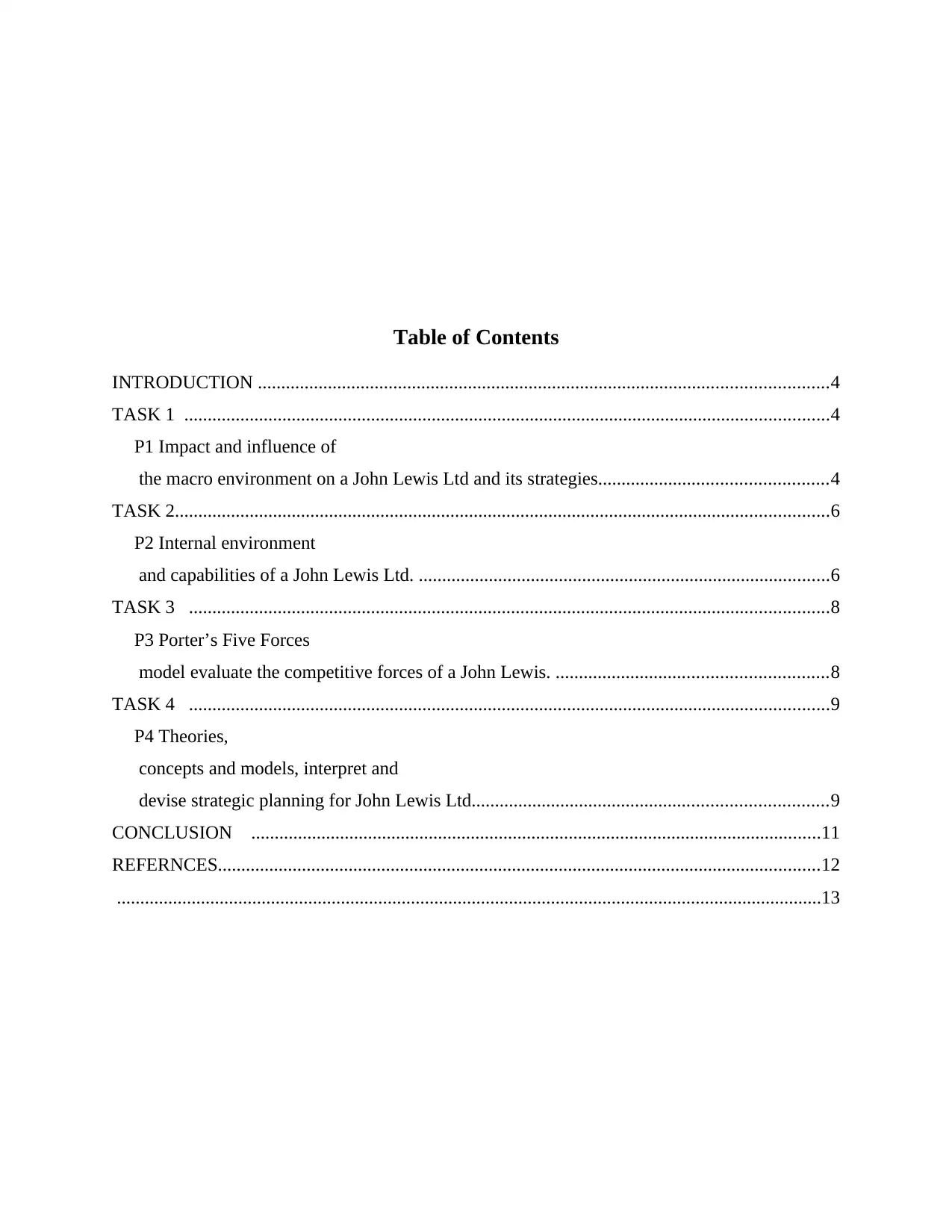
Table of Contents
INTRODUCTION ..........................................................................................................................4
TASK 1 ..........................................................................................................................................4
P1 Impact and influence of
the macro environment on a John Lewis Ltd and its strategies.................................................4
TASK 2............................................................................................................................................6
P2 Internal environment
and capabilities of a John Lewis Ltd. ........................................................................................6
TASK 3 .........................................................................................................................................8
P3 Porter’s Five Forces
model evaluate the competitive forces of a John Lewis. ..........................................................8
TASK 4 .........................................................................................................................................9
P4 Theories,
concepts and models, interpret and
devise strategic planning for John Lewis Ltd............................................................................9
CONCLUSION ..........................................................................................................................11
REFERNCES.................................................................................................................................12
.......................................................................................................................................................13
INTRODUCTION ..........................................................................................................................4
TASK 1 ..........................................................................................................................................4
P1 Impact and influence of
the macro environment on a John Lewis Ltd and its strategies.................................................4
TASK 2............................................................................................................................................6
P2 Internal environment
and capabilities of a John Lewis Ltd. ........................................................................................6
TASK 3 .........................................................................................................................................8
P3 Porter’s Five Forces
model evaluate the competitive forces of a John Lewis. ..........................................................8
TASK 4 .........................................................................................................................................9
P4 Theories,
concepts and models, interpret and
devise strategic planning for John Lewis Ltd............................................................................9
CONCLUSION ..........................................................................................................................11
REFERNCES.................................................................................................................................12
.......................................................................................................................................................13

INTRODUCTION
Business environment is the mixture of all forces, factors which are external and beyond
the control of an organisation but which exercise a significant influence on the functioning and
growth of a business enterprise (Akter and et. al., 2016). It is dynamic and flexible as it provides
enormous opportunity to company and enable them to adapt innovative technology in order to
maximise the profit effectively. In context to John Lewis Ltd, leading retailer chain of high end
department store which is founded in the year of 1864. It is headquartered in London UK which
is diversified in home ware, electricals, clothing etc. It is well known for identifying the
opportunities and threat which enable them to face the challenges and helped them to capture the
market. This research covers the impact of internal and external environment on business
strategies, usage of Porter's Five force model to evaluate competitive forces. Along with this
theories, concepts, models are also mentioned in this report which help in implementing strategic
planning within organisation.
TASK 1
P1 Impact and influence of
the macro environment on a John Lewis Ltd and its strategies.
Business environment encompasses of internal and external environment of company
which has greatly impact on its functioning and operations. It includes several factors like
competitors, government, customer, political, legal, economic and legal conditions. Business
environment is unpredictable as it keeps on changing according to the economic, culture changes
and it effect its growth (Anwar and Hasnu, 2016). It has control over internal environment(within
the organisation) while it has no control on external environment (outside the company).
External environment is classified into micro environment and macro environment. Micro
environment has direct impact on company and it includes customer, suppliers, competition etc.
On the other other hand macro environment signifies the general environment and influence
company indirectly and it contains several factors like political, legal, economic, technological
etc. It helps company to identify the opportunities and threats and enable them to meet out the
challenges effectively. Apart from this it enable the company to recognise the competitors
strategy and based on that they formulate their own business strategy in order to capture the
market effectively and efficiently. Business strategy is the framework which is prepared by
Business environment is the mixture of all forces, factors which are external and beyond
the control of an organisation but which exercise a significant influence on the functioning and
growth of a business enterprise (Akter and et. al., 2016). It is dynamic and flexible as it provides
enormous opportunity to company and enable them to adapt innovative technology in order to
maximise the profit effectively. In context to John Lewis Ltd, leading retailer chain of high end
department store which is founded in the year of 1864. It is headquartered in London UK which
is diversified in home ware, electricals, clothing etc. It is well known for identifying the
opportunities and threat which enable them to face the challenges and helped them to capture the
market. This research covers the impact of internal and external environment on business
strategies, usage of Porter's Five force model to evaluate competitive forces. Along with this
theories, concepts, models are also mentioned in this report which help in implementing strategic
planning within organisation.
TASK 1
P1 Impact and influence of
the macro environment on a John Lewis Ltd and its strategies.
Business environment encompasses of internal and external environment of company
which has greatly impact on its functioning and operations. It includes several factors like
competitors, government, customer, political, legal, economic and legal conditions. Business
environment is unpredictable as it keeps on changing according to the economic, culture changes
and it effect its growth (Anwar and Hasnu, 2016). It has control over internal environment(within
the organisation) while it has no control on external environment (outside the company).
External environment is classified into micro environment and macro environment. Micro
environment has direct impact on company and it includes customer, suppliers, competition etc.
On the other other hand macro environment signifies the general environment and influence
company indirectly and it contains several factors like political, legal, economic, technological
etc. It helps company to identify the opportunities and threats and enable them to meet out the
challenges effectively. Apart from this it enable the company to recognise the competitors
strategy and based on that they formulate their own business strategy in order to capture the
market effectively and efficiently. Business strategy is the framework which is prepared by
⊘ This is a preview!⊘
Do you want full access?
Subscribe today to unlock all pages.

Trusted by 1+ million students worldwide
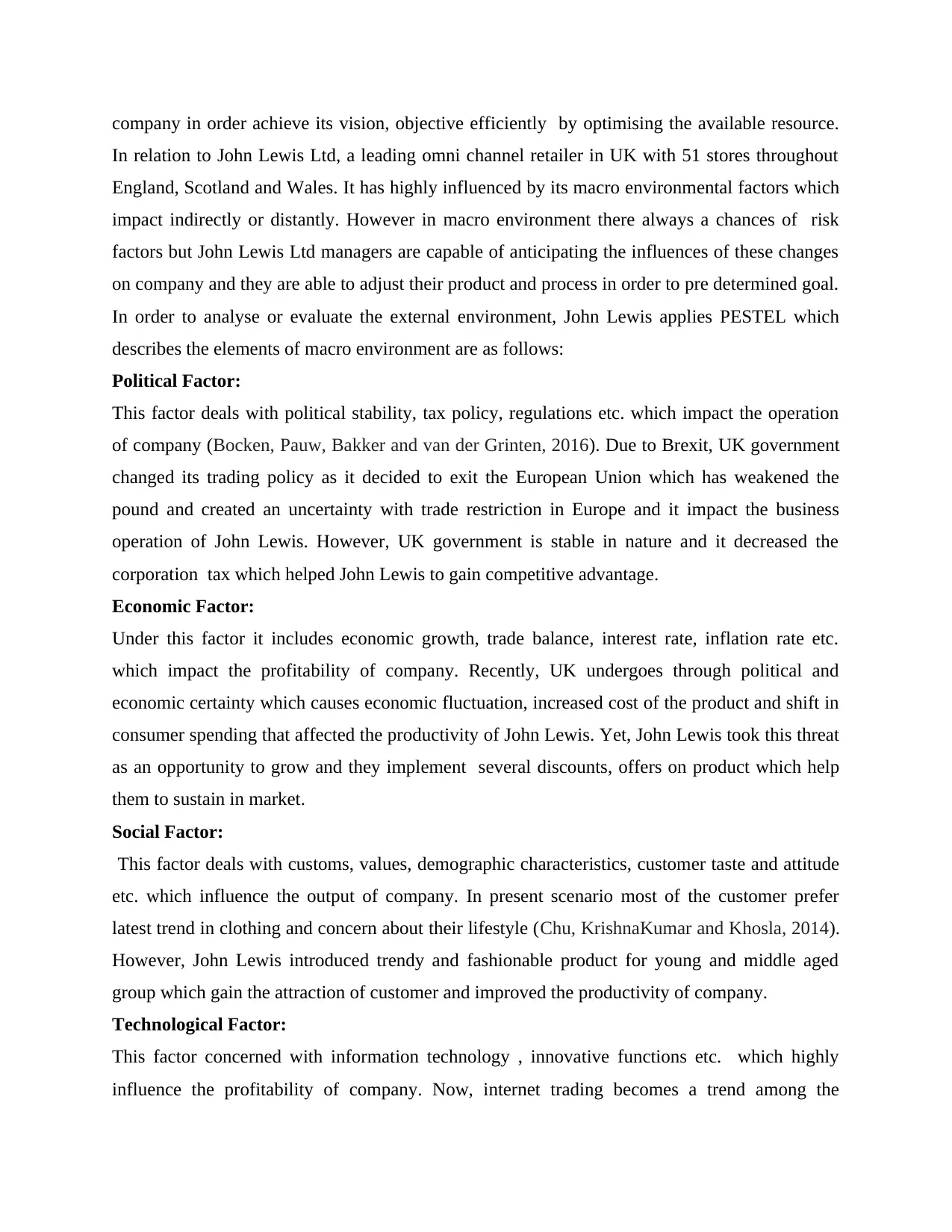
company in order achieve its vision, objective efficiently by optimising the available resource.
In relation to John Lewis Ltd, a leading omni channel retailer in UK with 51 stores throughout
England, Scotland and Wales. It has highly influenced by its macro environmental factors which
impact indirectly or distantly. However in macro environment there always a chances of risk
factors but John Lewis Ltd managers are capable of anticipating the influences of these changes
on company and they are able to adjust their product and process in order to pre determined goal.
In order to analyse or evaluate the external environment, John Lewis applies PESTEL which
describes the elements of macro environment are as follows:
Political Factor:
This factor deals with political stability, tax policy, regulations etc. which impact the operation
of company (Bocken, Pauw, Bakker and van der Grinten, 2016). Due to Brexit, UK government
changed its trading policy as it decided to exit the European Union which has weakened the
pound and created an uncertainty with trade restriction in Europe and it impact the business
operation of John Lewis. However, UK government is stable in nature and it decreased the
corporation tax which helped John Lewis to gain competitive advantage.
Economic Factor:
Under this factor it includes economic growth, trade balance, interest rate, inflation rate etc.
which impact the profitability of company. Recently, UK undergoes through political and
economic certainty which causes economic fluctuation, increased cost of the product and shift in
consumer spending that affected the productivity of John Lewis. Yet, John Lewis took this threat
as an opportunity to grow and they implement several discounts, offers on product which help
them to sustain in market.
Social Factor:
This factor deals with customs, values, demographic characteristics, customer taste and attitude
etc. which influence the output of company. In present scenario most of the customer prefer
latest trend in clothing and concern about their lifestyle (Chu, KrishnaKumar and Khosla, 2014).
However, John Lewis introduced trendy and fashionable product for young and middle aged
group which gain the attraction of customer and improved the productivity of company.
Technological Factor:
This factor concerned with information technology , innovative functions etc. which highly
influence the profitability of company. Now, internet trading becomes a trend among the
In relation to John Lewis Ltd, a leading omni channel retailer in UK with 51 stores throughout
England, Scotland and Wales. It has highly influenced by its macro environmental factors which
impact indirectly or distantly. However in macro environment there always a chances of risk
factors but John Lewis Ltd managers are capable of anticipating the influences of these changes
on company and they are able to adjust their product and process in order to pre determined goal.
In order to analyse or evaluate the external environment, John Lewis applies PESTEL which
describes the elements of macro environment are as follows:
Political Factor:
This factor deals with political stability, tax policy, regulations etc. which impact the operation
of company (Bocken, Pauw, Bakker and van der Grinten, 2016). Due to Brexit, UK government
changed its trading policy as it decided to exit the European Union which has weakened the
pound and created an uncertainty with trade restriction in Europe and it impact the business
operation of John Lewis. However, UK government is stable in nature and it decreased the
corporation tax which helped John Lewis to gain competitive advantage.
Economic Factor:
Under this factor it includes economic growth, trade balance, interest rate, inflation rate etc.
which impact the profitability of company. Recently, UK undergoes through political and
economic certainty which causes economic fluctuation, increased cost of the product and shift in
consumer spending that affected the productivity of John Lewis. Yet, John Lewis took this threat
as an opportunity to grow and they implement several discounts, offers on product which help
them to sustain in market.
Social Factor:
This factor deals with customs, values, demographic characteristics, customer taste and attitude
etc. which influence the output of company. In present scenario most of the customer prefer
latest trend in clothing and concern about their lifestyle (Chu, KrishnaKumar and Khosla, 2014).
However, John Lewis introduced trendy and fashionable product for young and middle aged
group which gain the attraction of customer and improved the productivity of company.
Technological Factor:
This factor concerned with information technology , innovative functions etc. which highly
influence the profitability of company. Now, internet trading becomes a trend among the
Paraphrase This Document
Need a fresh take? Get an instant paraphrase of this document with our AI Paraphraser
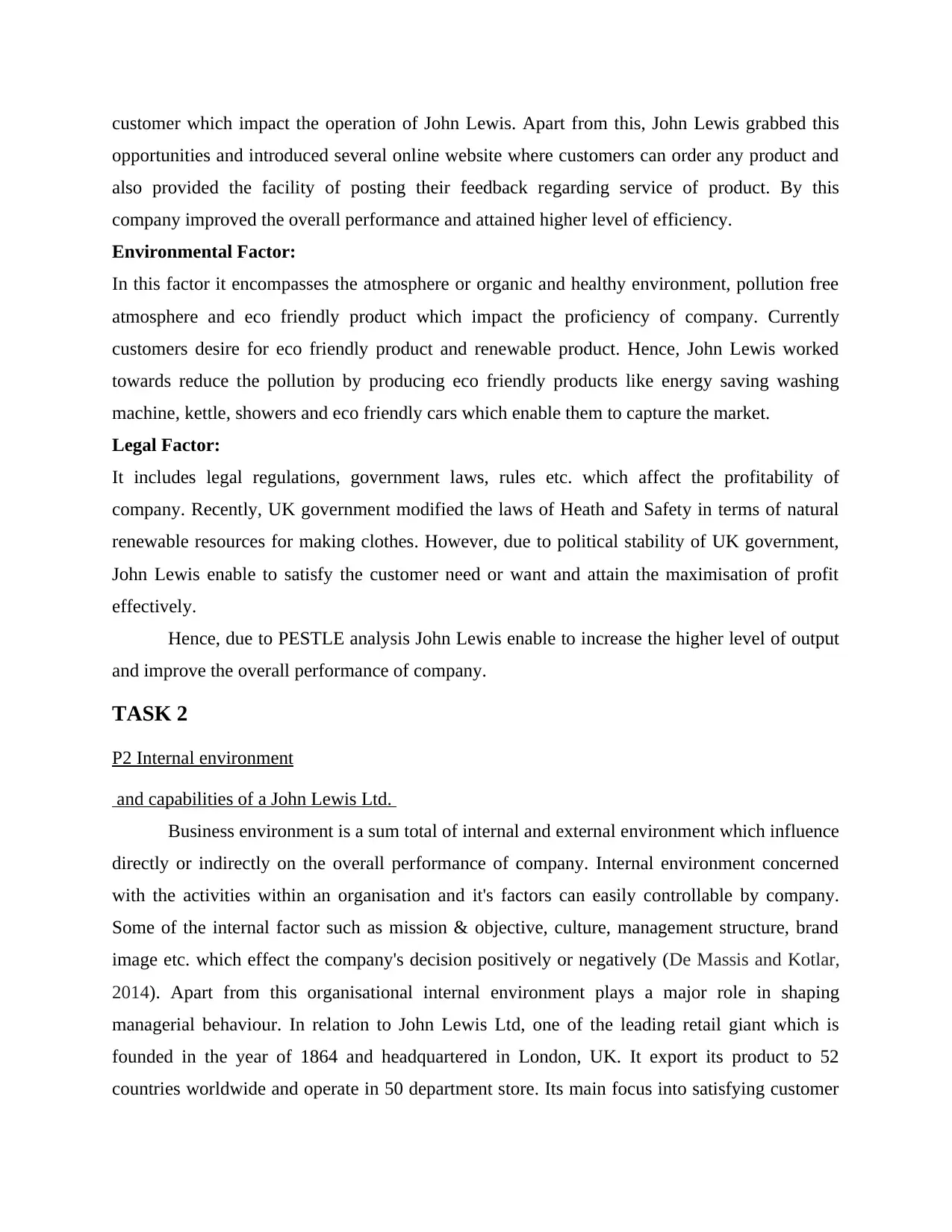
customer which impact the operation of John Lewis. Apart from this, John Lewis grabbed this
opportunities and introduced several online website where customers can order any product and
also provided the facility of posting their feedback regarding service of product. By this
company improved the overall performance and attained higher level of efficiency.
Environmental Factor:
In this factor it encompasses the atmosphere or organic and healthy environment, pollution free
atmosphere and eco friendly product which impact the proficiency of company. Currently
customers desire for eco friendly product and renewable product. Hence, John Lewis worked
towards reduce the pollution by producing eco friendly products like energy saving washing
machine, kettle, showers and eco friendly cars which enable them to capture the market.
Legal Factor:
It includes legal regulations, government laws, rules etc. which affect the profitability of
company. Recently, UK government modified the laws of Heath and Safety in terms of natural
renewable resources for making clothes. However, due to political stability of UK government,
John Lewis enable to satisfy the customer need or want and attain the maximisation of profit
effectively.
Hence, due to PESTLE analysis John Lewis enable to increase the higher level of output
and improve the overall performance of company.
TASK 2
P2 Internal environment
and capabilities of a John Lewis Ltd.
Business environment is a sum total of internal and external environment which influence
directly or indirectly on the overall performance of company. Internal environment concerned
with the activities within an organisation and it's factors can easily controllable by company.
Some of the internal factor such as mission & objective, culture, management structure, brand
image etc. which effect the company's decision positively or negatively (De Massis and Kotlar,
2014). Apart from this organisational internal environment plays a major role in shaping
managerial behaviour. In relation to John Lewis Ltd, one of the leading retail giant which is
founded in the year of 1864 and headquartered in London, UK. It export its product to 52
countries worldwide and operate in 50 department store. Its main focus into satisfying customer
opportunities and introduced several online website where customers can order any product and
also provided the facility of posting their feedback regarding service of product. By this
company improved the overall performance and attained higher level of efficiency.
Environmental Factor:
In this factor it encompasses the atmosphere or organic and healthy environment, pollution free
atmosphere and eco friendly product which impact the proficiency of company. Currently
customers desire for eco friendly product and renewable product. Hence, John Lewis worked
towards reduce the pollution by producing eco friendly products like energy saving washing
machine, kettle, showers and eco friendly cars which enable them to capture the market.
Legal Factor:
It includes legal regulations, government laws, rules etc. which affect the profitability of
company. Recently, UK government modified the laws of Heath and Safety in terms of natural
renewable resources for making clothes. However, due to political stability of UK government,
John Lewis enable to satisfy the customer need or want and attain the maximisation of profit
effectively.
Hence, due to PESTLE analysis John Lewis enable to increase the higher level of output
and improve the overall performance of company.
TASK 2
P2 Internal environment
and capabilities of a John Lewis Ltd.
Business environment is a sum total of internal and external environment which influence
directly or indirectly on the overall performance of company. Internal environment concerned
with the activities within an organisation and it's factors can easily controllable by company.
Some of the internal factor such as mission & objective, culture, management structure, brand
image etc. which effect the company's decision positively or negatively (De Massis and Kotlar,
2014). Apart from this organisational internal environment plays a major role in shaping
managerial behaviour. In relation to John Lewis Ltd, one of the leading retail giant which is
founded in the year of 1864 and headquartered in London, UK. It export its product to 52
countries worldwide and operate in 50 department store. Its main focus into satisfying customer
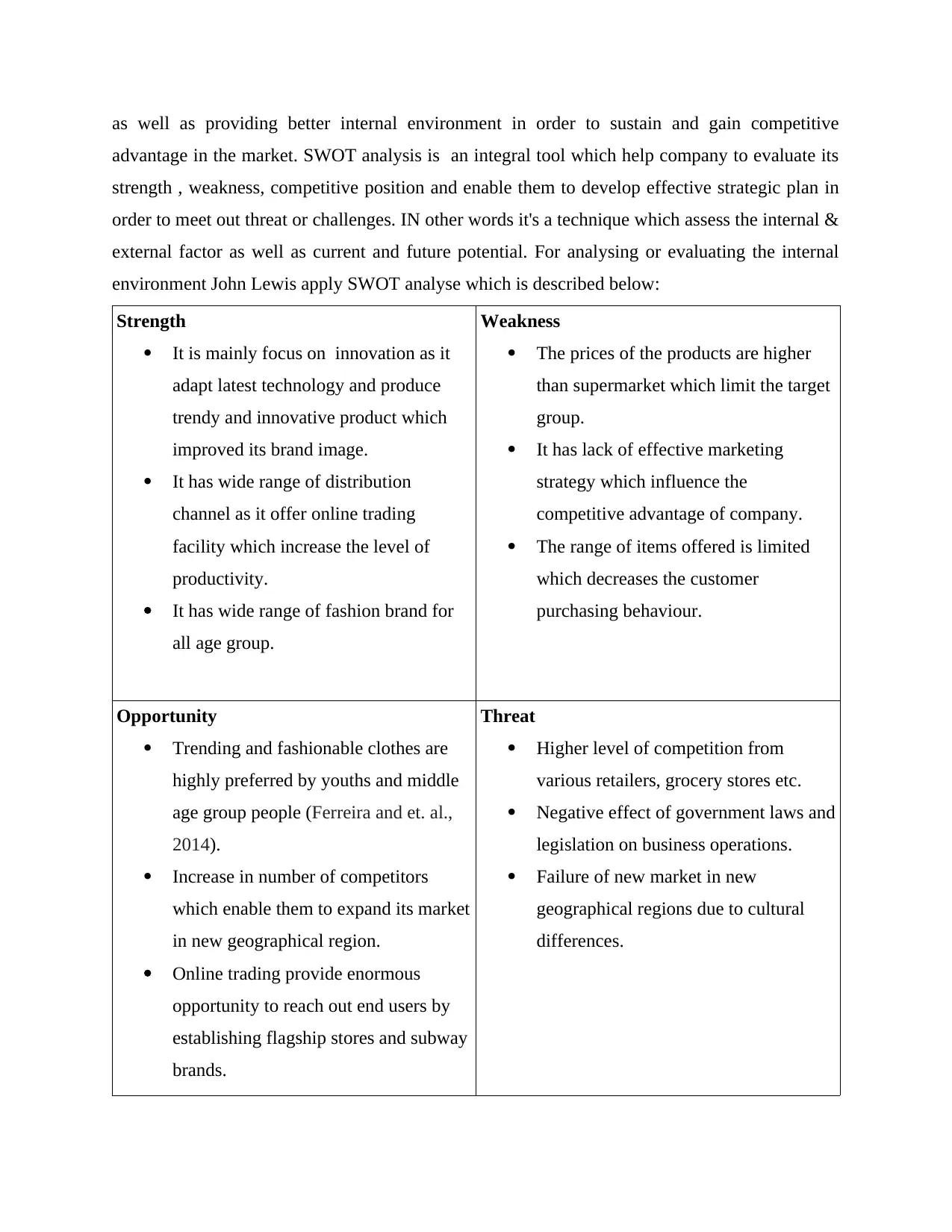
as well as providing better internal environment in order to sustain and gain competitive
advantage in the market. SWOT analysis is an integral tool which help company to evaluate its
strength , weakness, competitive position and enable them to develop effective strategic plan in
order to meet out threat or challenges. IN other words it's a technique which assess the internal &
external factor as well as current and future potential. For analysing or evaluating the internal
environment John Lewis apply SWOT analyse which is described below:
Strength
It is mainly focus on innovation as it
adapt latest technology and produce
trendy and innovative product which
improved its brand image.
It has wide range of distribution
channel as it offer online trading
facility which increase the level of
productivity.
It has wide range of fashion brand for
all age group.
Weakness
The prices of the products are higher
than supermarket which limit the target
group.
It has lack of effective marketing
strategy which influence the
competitive advantage of company.
The range of items offered is limited
which decreases the customer
purchasing behaviour.
Opportunity
Trending and fashionable clothes are
highly preferred by youths and middle
age group people (Ferreira and et. al.,
2014).
Increase in number of competitors
which enable them to expand its market
in new geographical region.
Online trading provide enormous
opportunity to reach out end users by
establishing flagship stores and subway
brands.
Threat
Higher level of competition from
various retailers, grocery stores etc.
Negative effect of government laws and
legislation on business operations.
Failure of new market in new
geographical regions due to cultural
differences.
advantage in the market. SWOT analysis is an integral tool which help company to evaluate its
strength , weakness, competitive position and enable them to develop effective strategic plan in
order to meet out threat or challenges. IN other words it's a technique which assess the internal &
external factor as well as current and future potential. For analysing or evaluating the internal
environment John Lewis apply SWOT analyse which is described below:
Strength
It is mainly focus on innovation as it
adapt latest technology and produce
trendy and innovative product which
improved its brand image.
It has wide range of distribution
channel as it offer online trading
facility which increase the level of
productivity.
It has wide range of fashion brand for
all age group.
Weakness
The prices of the products are higher
than supermarket which limit the target
group.
It has lack of effective marketing
strategy which influence the
competitive advantage of company.
The range of items offered is limited
which decreases the customer
purchasing behaviour.
Opportunity
Trending and fashionable clothes are
highly preferred by youths and middle
age group people (Ferreira and et. al.,
2014).
Increase in number of competitors
which enable them to expand its market
in new geographical region.
Online trading provide enormous
opportunity to reach out end users by
establishing flagship stores and subway
brands.
Threat
Higher level of competition from
various retailers, grocery stores etc.
Negative effect of government laws and
legislation on business operations.
Failure of new market in new
geographical regions due to cultural
differences.
⊘ This is a preview!⊘
Do you want full access?
Subscribe today to unlock all pages.

Trusted by 1+ million students worldwide
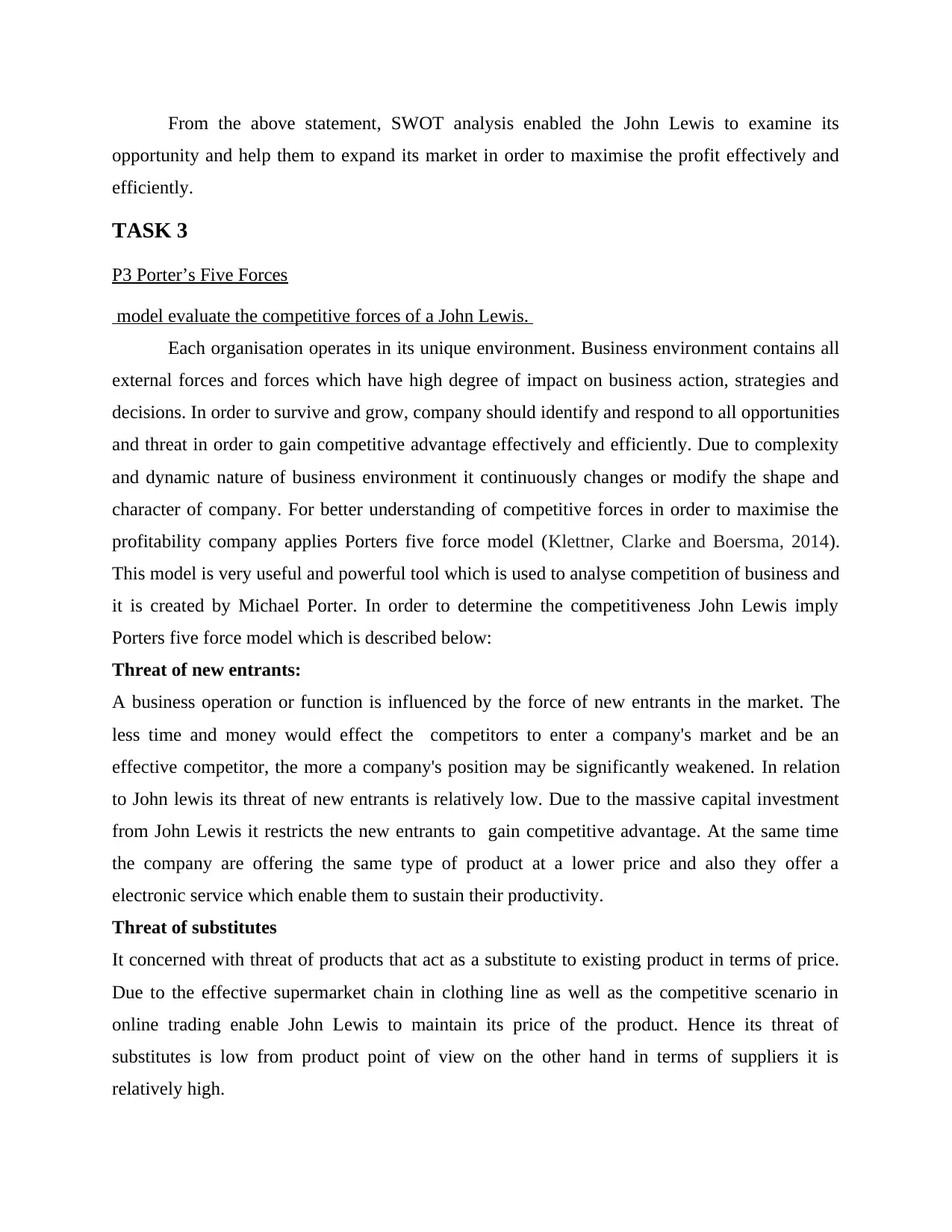
From the above statement, SWOT analysis enabled the John Lewis to examine its
opportunity and help them to expand its market in order to maximise the profit effectively and
efficiently.
TASK 3
P3 Porter’s Five Forces
model evaluate the competitive forces of a John Lewis.
Each organisation operates in its unique environment. Business environment contains all
external forces and forces which have high degree of impact on business action, strategies and
decisions. In order to survive and grow, company should identify and respond to all opportunities
and threat in order to gain competitive advantage effectively and efficiently. Due to complexity
and dynamic nature of business environment it continuously changes or modify the shape and
character of company. For better understanding of competitive forces in order to maximise the
profitability company applies Porters five force model (Klettner, Clarke and Boersma, 2014).
This model is very useful and powerful tool which is used to analyse competition of business and
it is created by Michael Porter. In order to determine the competitiveness John Lewis imply
Porters five force model which is described below:
Threat of new entrants:
A business operation or function is influenced by the force of new entrants in the market. The
less time and money would effect the competitors to enter a company's market and be an
effective competitor, the more a company's position may be significantly weakened. In relation
to John lewis its threat of new entrants is relatively low. Due to the massive capital investment
from John Lewis it restricts the new entrants to gain competitive advantage. At the same time
the company are offering the same type of product at a lower price and also they offer a
electronic service which enable them to sustain their productivity.
Threat of substitutes
It concerned with threat of products that act as a substitute to existing product in terms of price.
Due to the effective supermarket chain in clothing line as well as the competitive scenario in
online trading enable John Lewis to maintain its price of the product. Hence its threat of
substitutes is low from product point of view on the other hand in terms of suppliers it is
relatively high.
opportunity and help them to expand its market in order to maximise the profit effectively and
efficiently.
TASK 3
P3 Porter’s Five Forces
model evaluate the competitive forces of a John Lewis.
Each organisation operates in its unique environment. Business environment contains all
external forces and forces which have high degree of impact on business action, strategies and
decisions. In order to survive and grow, company should identify and respond to all opportunities
and threat in order to gain competitive advantage effectively and efficiently. Due to complexity
and dynamic nature of business environment it continuously changes or modify the shape and
character of company. For better understanding of competitive forces in order to maximise the
profitability company applies Porters five force model (Klettner, Clarke and Boersma, 2014).
This model is very useful and powerful tool which is used to analyse competition of business and
it is created by Michael Porter. In order to determine the competitiveness John Lewis imply
Porters five force model which is described below:
Threat of new entrants:
A business operation or function is influenced by the force of new entrants in the market. The
less time and money would effect the competitors to enter a company's market and be an
effective competitor, the more a company's position may be significantly weakened. In relation
to John lewis its threat of new entrants is relatively low. Due to the massive capital investment
from John Lewis it restricts the new entrants to gain competitive advantage. At the same time
the company are offering the same type of product at a lower price and also they offer a
electronic service which enable them to sustain their productivity.
Threat of substitutes
It concerned with threat of products that act as a substitute to existing product in terms of price.
Due to the effective supermarket chain in clothing line as well as the competitive scenario in
online trading enable John Lewis to maintain its price of the product. Hence its threat of
substitutes is low from product point of view on the other hand in terms of suppliers it is
relatively high.
Paraphrase This Document
Need a fresh take? Get an instant paraphrase of this document with our AI Paraphraser

Bargaining power of buyers
This factor is considerably deals with the ability of customers to drive price of the product
down . It is affected by how many customers a company has and their significance level towards
the product (Leonidou and et. al., 2017). In case of John Lewis its bargaining power of buyer is
extremely high because the enormous competitors are available in the market which provide
large number of option to customer with unprecedented choice. Apart from this, John Lewis
effectively manage the factors like location, price, quality which make them to attain higher level
of proficiency.
Bargaining power of suppliers
This force deals with the potentiality or capability of supplier to drive up the price of products
and services. It is influenced by number of suppliers of goods or services, unique feature of
product among other product etc. Due to the restriction in the supply of raw material in the
global aspect which enable the suppliers to gain favourable position in market. Hence it results
into high bargaining power of supplier in John Lewis as it help them to capture the market and
gain competitive advantage effectively and efficiently.
Rivalry among competitors
The main focus of this force is the ability or capability of competitors to capture the market as
well as threaten among competitors. When competitive rivalry is low, a company has greater
power to do what it wants to do to achieve higher sales and profits. Rivalry among competitors
usually occurs due to the immense choice available in market as well as adaption of digital
trading creates competition and opposition. One of the main reason behind the success of John
Lewis is the adaption of innovative promotional campaign which improves the overall
performance of company and enable them to attain maximisation of profit.
However, Porter five force model helped John Lewis to increase higher level of
efficiency with the optimum utilisation of resources. Furthermore it enable them to determine its
threats and encourage them to implement corrective course of action.
This factor is considerably deals with the ability of customers to drive price of the product
down . It is affected by how many customers a company has and their significance level towards
the product (Leonidou and et. al., 2017). In case of John Lewis its bargaining power of buyer is
extremely high because the enormous competitors are available in the market which provide
large number of option to customer with unprecedented choice. Apart from this, John Lewis
effectively manage the factors like location, price, quality which make them to attain higher level
of proficiency.
Bargaining power of suppliers
This force deals with the potentiality or capability of supplier to drive up the price of products
and services. It is influenced by number of suppliers of goods or services, unique feature of
product among other product etc. Due to the restriction in the supply of raw material in the
global aspect which enable the suppliers to gain favourable position in market. Hence it results
into high bargaining power of supplier in John Lewis as it help them to capture the market and
gain competitive advantage effectively and efficiently.
Rivalry among competitors
The main focus of this force is the ability or capability of competitors to capture the market as
well as threaten among competitors. When competitive rivalry is low, a company has greater
power to do what it wants to do to achieve higher sales and profits. Rivalry among competitors
usually occurs due to the immense choice available in market as well as adaption of digital
trading creates competition and opposition. One of the main reason behind the success of John
Lewis is the adaption of innovative promotional campaign which improves the overall
performance of company and enable them to attain maximisation of profit.
However, Porter five force model helped John Lewis to increase higher level of
efficiency with the optimum utilisation of resources. Furthermore it enable them to determine its
threats and encourage them to implement corrective course of action.
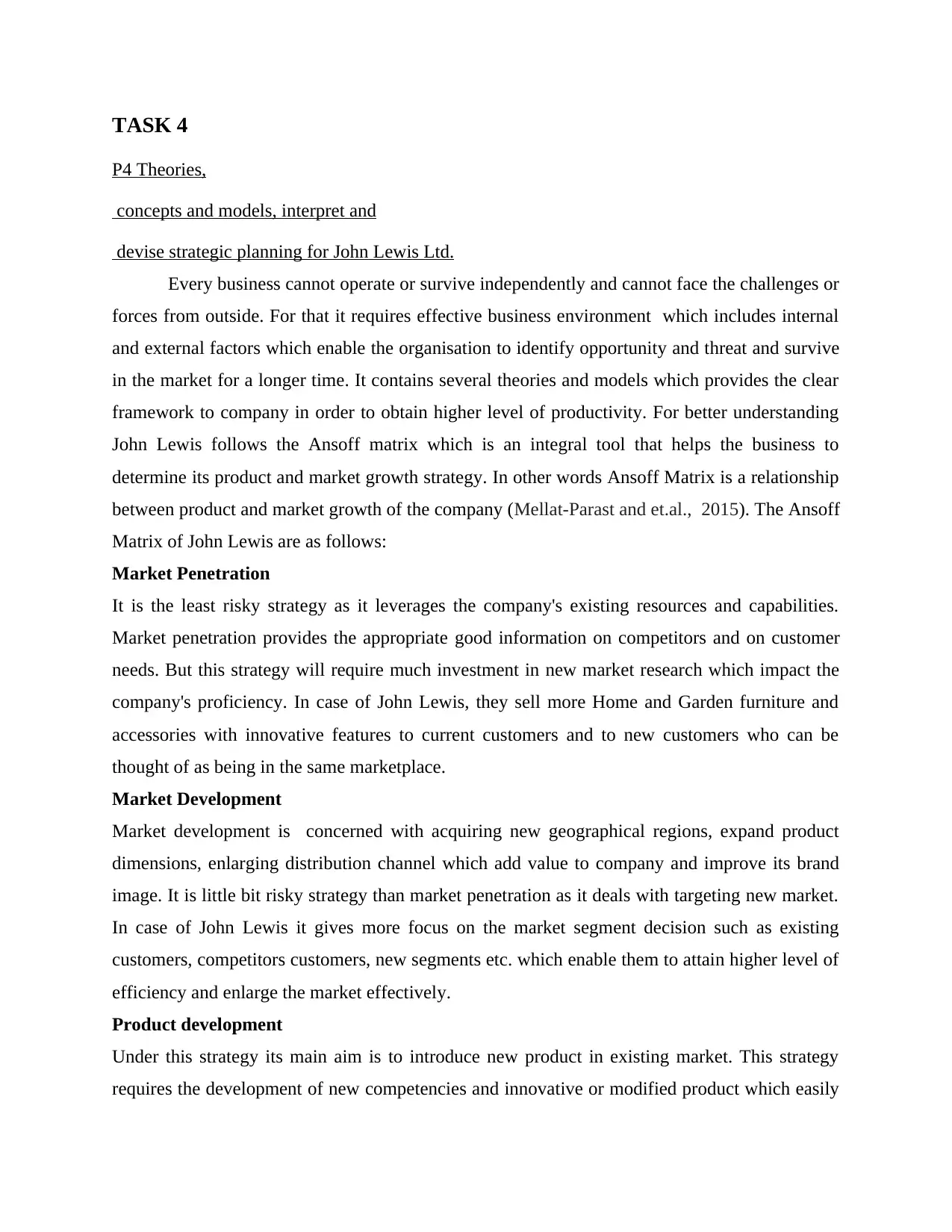
TASK 4
P4 Theories,
concepts and models, interpret and
devise strategic planning for John Lewis Ltd.
Every business cannot operate or survive independently and cannot face the challenges or
forces from outside. For that it requires effective business environment which includes internal
and external factors which enable the organisation to identify opportunity and threat and survive
in the market for a longer time. It contains several theories and models which provides the clear
framework to company in order to obtain higher level of productivity. For better understanding
John Lewis follows the Ansoff matrix which is an integral tool that helps the business to
determine its product and market growth strategy. In other words Ansoff Matrix is a relationship
between product and market growth of the company (Mellat-Parast and et.al., 2015). The Ansoff
Matrix of John Lewis are as follows:
Market Penetration
It is the least risky strategy as it leverages the company's existing resources and capabilities.
Market penetration provides the appropriate good information on competitors and on customer
needs. But this strategy will require much investment in new market research which impact the
company's proficiency. In case of John Lewis, they sell more Home and Garden furniture and
accessories with innovative features to current customers and to new customers who can be
thought of as being in the same marketplace.
Market Development
Market development is concerned with acquiring new geographical regions, expand product
dimensions, enlarging distribution channel which add value to company and improve its brand
image. It is little bit risky strategy than market penetration as it deals with targeting new market.
In case of John Lewis it gives more focus on the market segment decision such as existing
customers, competitors customers, new segments etc. which enable them to attain higher level of
efficiency and enlarge the market effectively.
Product development
Under this strategy its main aim is to introduce new product in existing market. This strategy
requires the development of new competencies and innovative or modified product which easily
P4 Theories,
concepts and models, interpret and
devise strategic planning for John Lewis Ltd.
Every business cannot operate or survive independently and cannot face the challenges or
forces from outside. For that it requires effective business environment which includes internal
and external factors which enable the organisation to identify opportunity and threat and survive
in the market for a longer time. It contains several theories and models which provides the clear
framework to company in order to obtain higher level of productivity. For better understanding
John Lewis follows the Ansoff matrix which is an integral tool that helps the business to
determine its product and market growth strategy. In other words Ansoff Matrix is a relationship
between product and market growth of the company (Mellat-Parast and et.al., 2015). The Ansoff
Matrix of John Lewis are as follows:
Market Penetration
It is the least risky strategy as it leverages the company's existing resources and capabilities.
Market penetration provides the appropriate good information on competitors and on customer
needs. But this strategy will require much investment in new market research which impact the
company's proficiency. In case of John Lewis, they sell more Home and Garden furniture and
accessories with innovative features to current customers and to new customers who can be
thought of as being in the same marketplace.
Market Development
Market development is concerned with acquiring new geographical regions, expand product
dimensions, enlarging distribution channel which add value to company and improve its brand
image. It is little bit risky strategy than market penetration as it deals with targeting new market.
In case of John Lewis it gives more focus on the market segment decision such as existing
customers, competitors customers, new segments etc. which enable them to attain higher level of
efficiency and enlarge the market effectively.
Product development
Under this strategy its main aim is to introduce new product in existing market. This strategy
requires the development of new competencies and innovative or modified product which easily
⊘ This is a preview!⊘
Do you want full access?
Subscribe today to unlock all pages.

Trusted by 1+ million students worldwide
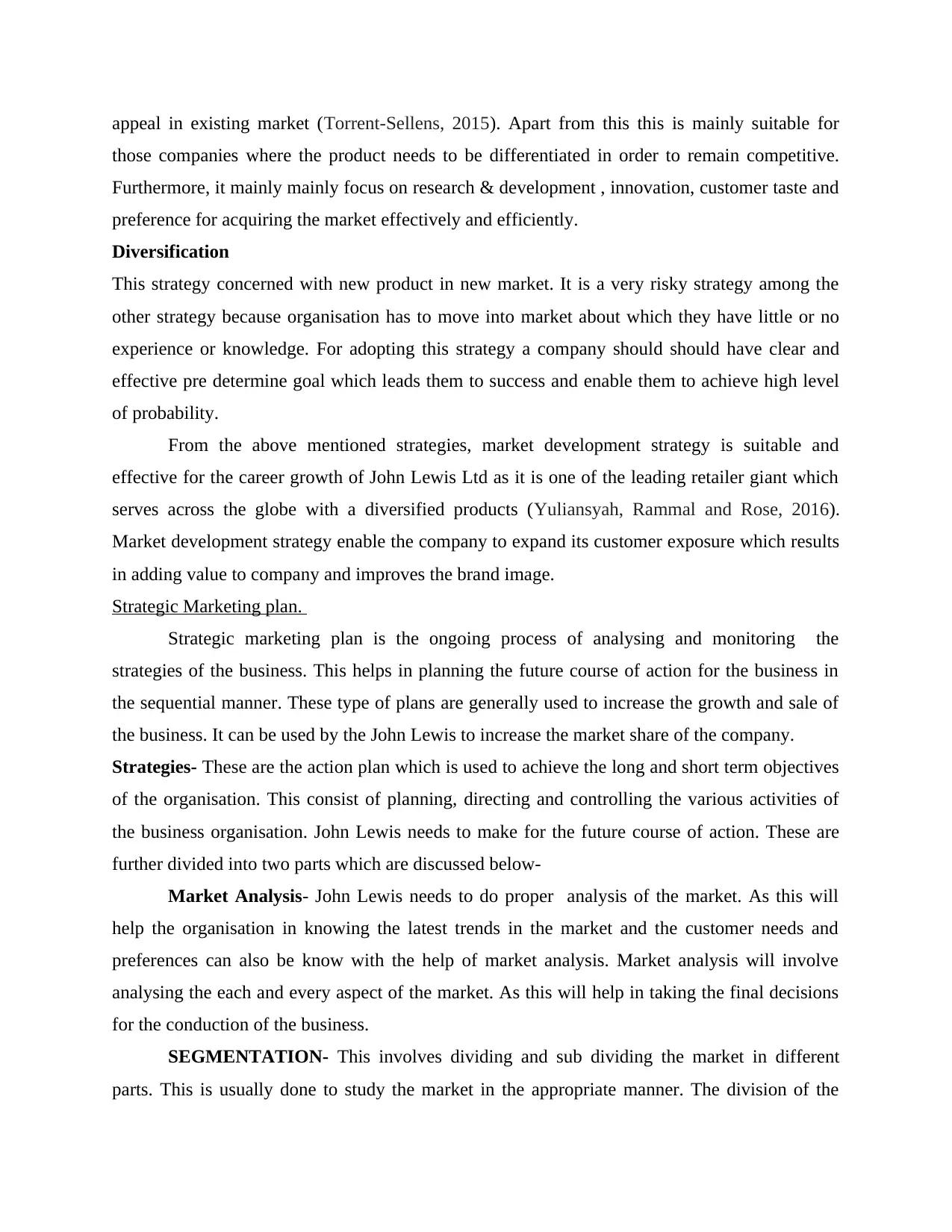
appeal in existing market (Torrent-Sellens, 2015). Apart from this this is mainly suitable for
those companies where the product needs to be differentiated in order to remain competitive.
Furthermore, it mainly mainly focus on research & development , innovation, customer taste and
preference for acquiring the market effectively and efficiently.
Diversification
This strategy concerned with new product in new market. It is a very risky strategy among the
other strategy because organisation has to move into market about which they have little or no
experience or knowledge. For adopting this strategy a company should should have clear and
effective pre determine goal which leads them to success and enable them to achieve high level
of probability.
From the above mentioned strategies, market development strategy is suitable and
effective for the career growth of John Lewis Ltd as it is one of the leading retailer giant which
serves across the globe with a diversified products (Yuliansyah, Rammal and Rose, 2016).
Market development strategy enable the company to expand its customer exposure which results
in adding value to company and improves the brand image.
Strategic Marketing plan.
Strategic marketing plan is the ongoing process of analysing and monitoring the
strategies of the business. This helps in planning the future course of action for the business in
the sequential manner. These type of plans are generally used to increase the growth and sale of
the business. It can be used by the John Lewis to increase the market share of the company.
Strategies- These are the action plan which is used to achieve the long and short term objectives
of the organisation. This consist of planning, directing and controlling the various activities of
the business organisation. John Lewis needs to make for the future course of action. These are
further divided into two parts which are discussed below-
Market Analysis- John Lewis needs to do proper analysis of the market. As this will
help the organisation in knowing the latest trends in the market and the customer needs and
preferences can also be know with the help of market analysis. Market analysis will involve
analysing the each and every aspect of the market. As this will help in taking the final decisions
for the conduction of the business.
SEGMENTATION- This involves dividing and sub dividing the market in different
parts. This is usually done to study the market in the appropriate manner. The division of the
those companies where the product needs to be differentiated in order to remain competitive.
Furthermore, it mainly mainly focus on research & development , innovation, customer taste and
preference for acquiring the market effectively and efficiently.
Diversification
This strategy concerned with new product in new market. It is a very risky strategy among the
other strategy because organisation has to move into market about which they have little or no
experience or knowledge. For adopting this strategy a company should should have clear and
effective pre determine goal which leads them to success and enable them to achieve high level
of probability.
From the above mentioned strategies, market development strategy is suitable and
effective for the career growth of John Lewis Ltd as it is one of the leading retailer giant which
serves across the globe with a diversified products (Yuliansyah, Rammal and Rose, 2016).
Market development strategy enable the company to expand its customer exposure which results
in adding value to company and improves the brand image.
Strategic Marketing plan.
Strategic marketing plan is the ongoing process of analysing and monitoring the
strategies of the business. This helps in planning the future course of action for the business in
the sequential manner. These type of plans are generally used to increase the growth and sale of
the business. It can be used by the John Lewis to increase the market share of the company.
Strategies- These are the action plan which is used to achieve the long and short term objectives
of the organisation. This consist of planning, directing and controlling the various activities of
the business organisation. John Lewis needs to make for the future course of action. These are
further divided into two parts which are discussed below-
Market Analysis- John Lewis needs to do proper analysis of the market. As this will
help the organisation in knowing the latest trends in the market and the customer needs and
preferences can also be know with the help of market analysis. Market analysis will involve
analysing the each and every aspect of the market. As this will help in taking the final decisions
for the conduction of the business.
SEGMENTATION- This involves dividing and sub dividing the market in different
parts. This is usually done to study the market in the appropriate manner. The division of the
Paraphrase This Document
Need a fresh take? Get an instant paraphrase of this document with our AI Paraphraser

market can be done on the basis of demographic, geographic and psycho graphic factors. The
customers of John Lewis can be divided on basis of above factors.
Targeting- The special group of customers needs to be targeted by John Lewis if the
company wants to start its business in the new area. The customers can be targeted on the basis
of their paying capacity.
Positioning- The company needs to adopt new and innovative plans to attract more and
more customers. John Lewis can use its unique selling proposition to retain its customers.
Objectives- The major Objectives of John Lewis is to retain its customers and to increase the
sale of the company. The mission of the company needs to be kept in mind before executing the
new plan.
Packaging- The packaging of products of John Lewis must be attractive to the customers. If the
company wants to increase its business in different areas than the company must work on its
packaging. So that customers can end up buying the product.
CONCLUSION
From the above mention it has been concluded that business environment is an important
tool for the career growth of company. For achieving organisational goal effectively and
efficiently company should always aware about the opportunities which enable them to increase
its profitability and productivity (Teh and Corbitt, 2015). Along with company needs to analyse
their external factors so that they can easily reduce the negative impact on the performance of
company. This will directly contribute in successfully implementing strategy within the
organisation.
customers of John Lewis can be divided on basis of above factors.
Targeting- The special group of customers needs to be targeted by John Lewis if the
company wants to start its business in the new area. The customers can be targeted on the basis
of their paying capacity.
Positioning- The company needs to adopt new and innovative plans to attract more and
more customers. John Lewis can use its unique selling proposition to retain its customers.
Objectives- The major Objectives of John Lewis is to retain its customers and to increase the
sale of the company. The mission of the company needs to be kept in mind before executing the
new plan.
Packaging- The packaging of products of John Lewis must be attractive to the customers. If the
company wants to increase its business in different areas than the company must work on its
packaging. So that customers can end up buying the product.
CONCLUSION
From the above mention it has been concluded that business environment is an important
tool for the career growth of company. For achieving organisational goal effectively and
efficiently company should always aware about the opportunities which enable them to increase
its profitability and productivity (Teh and Corbitt, 2015). Along with company needs to analyse
their external factors so that they can easily reduce the negative impact on the performance of
company. This will directly contribute in successfully implementing strategy within the
organisation.
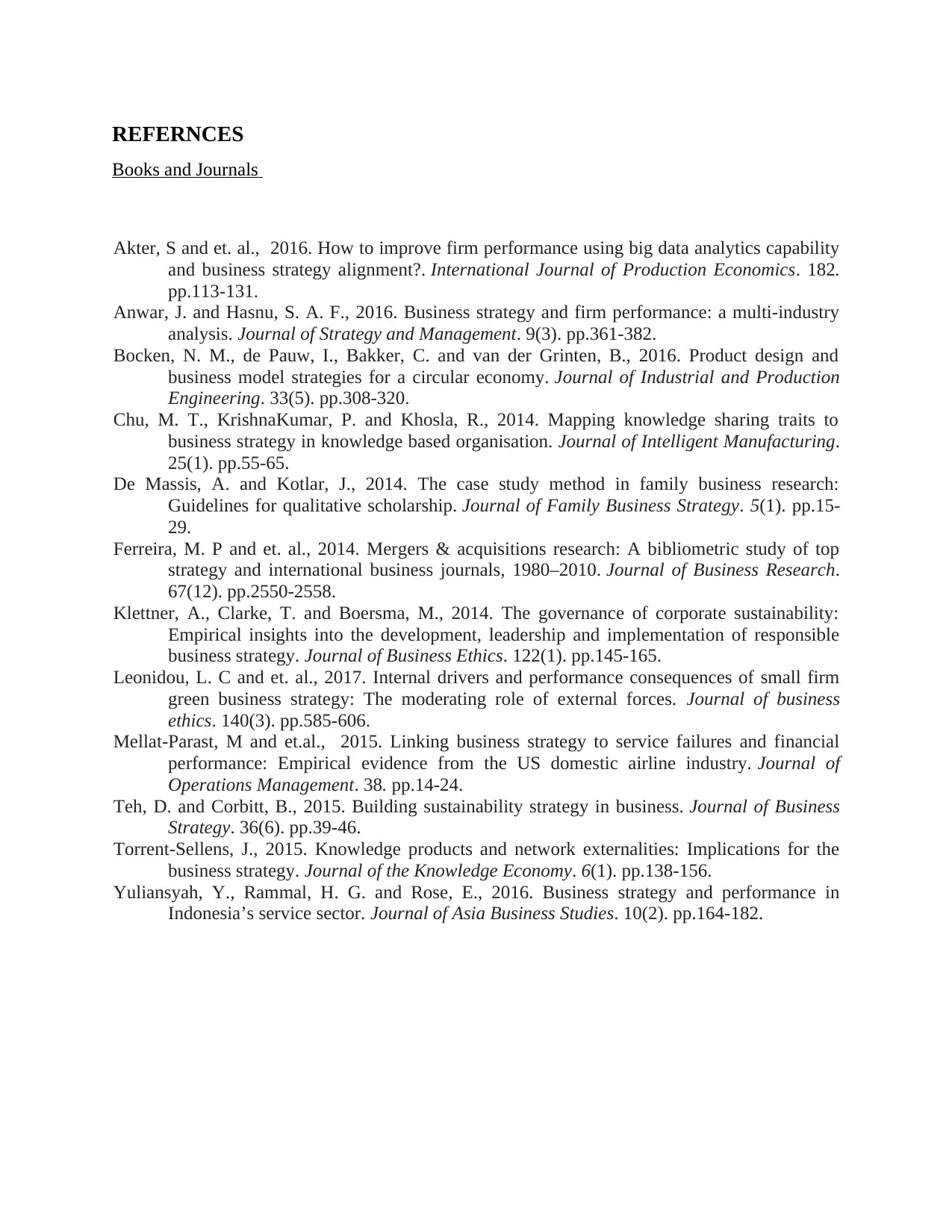
REFERNCES
Books and Journals
Akter, S and et. al., 2016. How to improve firm performance using big data analytics capability
and business strategy alignment?. International Journal of Production Economics. 182.
pp.113-131.
Anwar, J. and Hasnu, S. A. F., 2016. Business strategy and firm performance: a multi-industry
analysis. Journal of Strategy and Management. 9(3). pp.361-382.
Bocken, N. M., de Pauw, I., Bakker, C. and van der Grinten, B., 2016. Product design and
business model strategies for a circular economy. Journal of Industrial and Production
Engineering. 33(5). pp.308-320.
Chu, M. T., KrishnaKumar, P. and Khosla, R., 2014. Mapping knowledge sharing traits to
business strategy in knowledge based organisation. Journal of Intelligent Manufacturing.
25(1). pp.55-65.
De Massis, A. and Kotlar, J., 2014. The case study method in family business research:
Guidelines for qualitative scholarship. Journal of Family Business Strategy. 5(1). pp.15-
29.
Ferreira, M. P and et. al., 2014. Mergers & acquisitions research: A bibliometric study of top
strategy and international business journals, 1980–2010. Journal of Business Research.
67(12). pp.2550-2558.
Klettner, A., Clarke, T. and Boersma, M., 2014. The governance of corporate sustainability:
Empirical insights into the development, leadership and implementation of responsible
business strategy. Journal of Business Ethics. 122(1). pp.145-165.
Leonidou, L. C and et. al., 2017. Internal drivers and performance consequences of small firm
green business strategy: The moderating role of external forces. Journal of business
ethics. 140(3). pp.585-606.
Mellat-Parast, M and et.al., 2015. Linking business strategy to service failures and financial
performance: Empirical evidence from the US domestic airline industry. Journal of
Operations Management. 38. pp.14-24.
Teh, D. and Corbitt, B., 2015. Building sustainability strategy in business. Journal of Business
Strategy. 36(6). pp.39-46.
Torrent-Sellens, J., 2015. Knowledge products and network externalities: Implications for the
business strategy. Journal of the Knowledge Economy. 6(1). pp.138-156.
Yuliansyah, Y., Rammal, H. G. and Rose, E., 2016. Business strategy and performance in
Indonesia’s service sector. Journal of Asia Business Studies. 10(2). pp.164-182.
Books and Journals
Akter, S and et. al., 2016. How to improve firm performance using big data analytics capability
and business strategy alignment?. International Journal of Production Economics. 182.
pp.113-131.
Anwar, J. and Hasnu, S. A. F., 2016. Business strategy and firm performance: a multi-industry
analysis. Journal of Strategy and Management. 9(3). pp.361-382.
Bocken, N. M., de Pauw, I., Bakker, C. and van der Grinten, B., 2016. Product design and
business model strategies for a circular economy. Journal of Industrial and Production
Engineering. 33(5). pp.308-320.
Chu, M. T., KrishnaKumar, P. and Khosla, R., 2014. Mapping knowledge sharing traits to
business strategy in knowledge based organisation. Journal of Intelligent Manufacturing.
25(1). pp.55-65.
De Massis, A. and Kotlar, J., 2014. The case study method in family business research:
Guidelines for qualitative scholarship. Journal of Family Business Strategy. 5(1). pp.15-
29.
Ferreira, M. P and et. al., 2014. Mergers & acquisitions research: A bibliometric study of top
strategy and international business journals, 1980–2010. Journal of Business Research.
67(12). pp.2550-2558.
Klettner, A., Clarke, T. and Boersma, M., 2014. The governance of corporate sustainability:
Empirical insights into the development, leadership and implementation of responsible
business strategy. Journal of Business Ethics. 122(1). pp.145-165.
Leonidou, L. C and et. al., 2017. Internal drivers and performance consequences of small firm
green business strategy: The moderating role of external forces. Journal of business
ethics. 140(3). pp.585-606.
Mellat-Parast, M and et.al., 2015. Linking business strategy to service failures and financial
performance: Empirical evidence from the US domestic airline industry. Journal of
Operations Management. 38. pp.14-24.
Teh, D. and Corbitt, B., 2015. Building sustainability strategy in business. Journal of Business
Strategy. 36(6). pp.39-46.
Torrent-Sellens, J., 2015. Knowledge products and network externalities: Implications for the
business strategy. Journal of the Knowledge Economy. 6(1). pp.138-156.
Yuliansyah, Y., Rammal, H. G. and Rose, E., 2016. Business strategy and performance in
Indonesia’s service sector. Journal of Asia Business Studies. 10(2). pp.164-182.
⊘ This is a preview!⊘
Do you want full access?
Subscribe today to unlock all pages.

Trusted by 1+ million students worldwide
1 out of 13
Related Documents
Your All-in-One AI-Powered Toolkit for Academic Success.
+13062052269
info@desklib.com
Available 24*7 on WhatsApp / Email
![[object Object]](/_next/static/media/star-bottom.7253800d.svg)
Unlock your academic potential
Copyright © 2020–2025 A2Z Services. All Rights Reserved. Developed and managed by ZUCOL.





